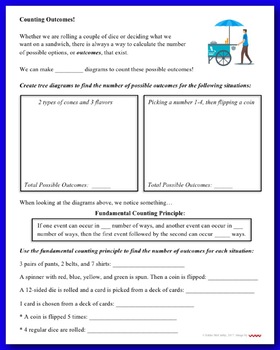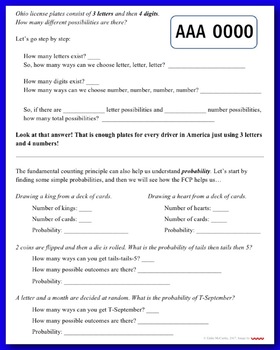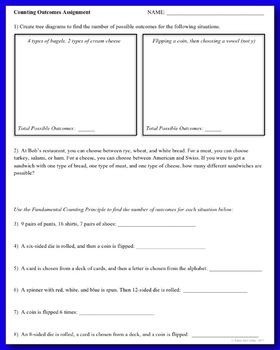Counting Outcomes and the Fundamental Counting Principle Guided Notes & Homework
Eddie McCarthy
1.2k Followers
Grade Levels
6th - 12th, Homeschool
Subjects
Resource Type
Standards
CCSS7.SP.C.8
CCSS7.SP.C.8a
CCSS7.SP.C.8b
Formats Included
- Zip
Pages
4 pages
Eddie McCarthy
1.2k Followers
What educators are saying
We're not given a ton of great resources for the counting principal. This was good practice for my kids! Thank you!
Description
* Download the preview for details! *
This lesson includes 2 pages of guided notes and a 2-page assignment.
Students learn about the fundamental counting principle in the order below. They will:
- Discover the concept through tree diagrams
- Practice applying it to different situations (dice, outfits, spinners, etc.)
- Discover how many different Ohio license plates are possible
- Relate the fundamental counting principle to probability
Answer key is included!
* This lesson leads into my Permutations and Combinations lesson. Click the link to check it out!
Total Pages
4 pages
Answer Key
Included
Teaching Duration
45 minutes
Report this resource to TPT
Reported resources will be reviewed by our team. Report this resource to let us know if this resource violates TPT’s content guidelines.
Standards
to see state-specific standards (only available in the US).
CCSS7.SP.C.8
Find probabilities of compound events using organized lists, tables, tree diagrams, and simulation.
CCSS7.SP.C.8a
Understand that, just as with simple events, the probability of a compound event is the fraction of outcomes in the sample space for which the compound event occurs.
CCSS7.SP.C.8b
Represent sample spaces for compound events using methods such as organized lists, tables and tree diagrams. For an event described in everyday language (e.g., “rolling double sixes”), identify the outcomes in the sample space which compose the event.





